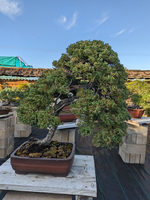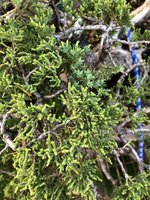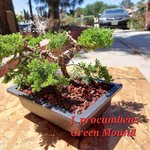You are using an out of date browser. It may not display this or other websites correctly.
You should upgrade or use an alternative browser.
You should upgrade or use an alternative browser.
Procumbens juvenile foliage?
- Thread starter Sagebrush
- Start date
WinstonWolfe
Yamadori
Yes, that will change after a couple seasons undisturbed. If it is continuously trimmed, it may take longer.
Wires_Guy_wires
Imperial Masterpiece
Aaand here in Europe, we don't even get the scale foliage 
MaciekA
Shohin
Yes, that will change after a couple seasons undisturbed. If it is continuously trimmed, it may take longer.
AFAIK, j. procumbens is full-time juvenile foliage form. I don't think it's going to revert to scale foliage.
WNC Bonsai
Masterpiece
If you wait long enough it can happen, just be patient and don’t upset it!AFAIK, j. procumbens is full-time juvenile foliage form. I don't think it's going to revert to scale foliage.
Baku1875
Shohin
In the photo is this what is referred to as juvenile foliage?
Im with Macie on this, procumbens and san jose are almost always juvenile and cannot be styled or pruned without reverting to juvenile with full force for a LONG time. Procumbens will only reach 25% scale-40% scale tops, if undisturbed and optimal conditions for years without pruning or styling(my conclusion from obsessive research on bnut and rest of internet).AFAIK, j. procumbens is full-time juvenile foliage form. I don't think it's going to revert to scale foliage.
IMO, embrace the juvenile foliage on the procumbens, and style it how you want. Make it the most interesting tree possible to the best of your abilities. Don't bother trying to go full scale. There's tons of world class procumbens that sport the juvenile leaves proudly.
ZombieNick
Shohin
Achieving adult foliage is very difficult, but it is not impossible. I didn't believe it myself until I saw it in person. Here is my sensei's "first tree" that I think people in the area are familiar with, as it has been shown a few times. It is consistently 90%+ adult foliage. These pictures don't do it much justice, but it looks almost like Itoigawa in person. In the close up, you can see some of the juvenile foliage pushing through, but the vast majority is scale:



Just to get some idea, this has been in a bonsai pot for 30+ years. I'd probably go with the other's suggestion and embrace the juvenile foilage, unless you have a lot of time and patience



Just to get some idea, this has been in a bonsai pot for 30+ years. I'd probably go with the other's suggestion and embrace the juvenile foilage, unless you have a lot of time and patience
Japonicus
Imperial Masterpiece
These threads ALWAYS get me, and not in a bad way.
It just catches me off guard. I'm just hard of learning I reckon.
I have more procumbens than anything, and they go scale in areas where I've
disturbed them more than usual. I should stay away from these threads because they make my mind go upside down.
To me, they're needle and stay that way until I thin a good deal, then they throw scale foliage which
I hate amid the rest of the needle foliage. I have embraced with love, the needle foliage of procumbens
It's just me. I'll be ok. I'm just glad someone replied before me this time lol. Old dog not tricky here.
It just catches me off guard. I'm just hard of learning I reckon.
I have more procumbens than anything, and they go scale in areas where I've
disturbed them more than usual. I should stay away from these threads because they make my mind go upside down.
To me, they're needle and stay that way until I thin a good deal, then they throw scale foliage which
I hate amid the rest of the needle foliage. I have embraced with love, the needle foliage of procumbens
It's just me. I'll be ok. I'm just glad someone replied before me this time lol. Old dog not tricky here.
Baku1875
Shohin
Inconsistency bothers me as well. If I had a nice procumbens, I would try to keep it needle instead of having a variety blend of needles and noodles.These threads ALWAYS get me, and not in a bad way.
It just catches me off guard. I'm just hard of learning I reckon.
I have more procumbens than anything, and they go scale in areas where I've
disturbed them more than usual. I should stay away from these threads because they make my mind go upside down.
To me, they're needle and stay that way until I thin a good deal, then they throw scale foliage which
I hate amid the rest of the needle foliage. I have embraced with love, the needle foliage of procumbens
It's just me. I'll be ok. I'm just glad someone replied before me this time lol. Old dog not tricky here.
I can achieve 95%-100% scale with my parsonis with styling, so it's worth it for me to strive for scale for consistency's sake on those
Clicio
Masterpiece
All my Procumbens are needle, even the cuttings, even the old ones.
Perhaps, as @Wires_Guy_wires has said, it's also a matter of location?
Perhaps, as @Wires_Guy_wires has said, it's also a matter of location?
Baku1875
Shohin
I have a theory (loosely based on conclusions on my limited knowledge of junipers)that longer day duration in late autumn for regions closer to the equator can have an effect on foliage type for junipers, and when combined with low humidity, it's possible to retain/develop scale foliage as a greater % of total foliage.All my Procumbens are needle, even the cuttings, even the old ones.
Perhaps, as @Wires_Guy_wires has said, it's also a matter of location?
So if ZombieNick's sensei is also in Los angeles, he would have the benefit of dry weather, and longer day duration in mid autumn, increasing the chances of scale foliage.
If someone on here has some knowledge on this, it would be interesting to hear
A few major cities and their late autumn day duration, and humidity
Rio
peak 13:30
May 15 11:01
shortest 10:43
humid
Miami
peak 13:45
Nov 15 10:53
shortest 10:32
humid
Los Angeles
peak 14:26
Nov 15 10:24
shortest 9:53
dry (more potential for scale foliage on juvi dominants?)
Amsterdam
peak 16:48
Nov 15 8:47
shortest 7:41
humid
Just some thoughts. It would be interesting to get a survey thread going of adult vs scale composition from different users and their different juniper types and map out a statistics based probability of foliage type.
Clicio
Masterpiece
As you can see, Rio and Miami are pretty close.I have a theory (loosely based on conclusions on my limited knowledge of junipers)that longer day duration in late autumn for regions closer to the equator can have an effect on foliage type for junipers, and when combined with low humidity, it's possible to retain/develop scale foliage as a greater % of total foliage.
So if ZombieNick's sensei is also in Los angeles, he would have the benefit of dry weather, and longer day duration in mid autumn, increasing the chances of scale foliage.
If someone on here has some knowledge on this, it would be interesting to hear
A few major cities and their late autumn day duration, and humidity
Rio
peak 13:30
May 15 11:01
shortest 10:43
humid
Miami
peak 13:45
Nov 15 10:53
shortest 10:32
humid
Los Angeles
peak 14:26
Nov 15 10:24
shortest 9:53
dry (more potential for scale foliage on juvi dominants?)
Amsterdam
peak 16:48
Nov 15 8:47
shortest 7:41
humid
Just some thoughts. It would be interesting to get a survey thread going of adult vs scale composition from different users and their different juniper types and map out a statistics based probability of foliage type.
I suppose it’s a good thing that my procumbens ’Nana can’t read BNut then. It doesn’t know it’s not supposed to do what it’s doing.Im with Macie on this, procumbens and san jose are almost always juvenile and cannot be styled or pruned without reverting to juvenile with full force for a LONG time. Procumbens will only reach 25% scale-40% scale tops, if undisturbed and optimal conditions for years without pruning or styling(my conclusion from obsessive research on bnut and rest of internet).
IMO, embrace the juvenile foliage on the procumbens, and style it how you want. Make it the most interesting tree possible to the best of your abilities. Don't bother trying to go full scale. There's tons of world class procumbens that sport the juvenile leaves proudly.

Ruddigger
Omono
Baku1875
Shohin
I like this stuff, now there's an out of the norm nana!I suppose it’s a good thing that my procumbens ’Nana can’t read BNut then. It doesn’t know it’s not supposed to do what it’s doing.
View attachment 488534
What do you think is your juvi/scale ratio overall and how much work have you done to it in the past 12 months? Looks like 70-80% scale from that shot.
Are scale heavy procumbens common in your area? Could be genetic, or an exceptionally happy tree?
I estimate it’s over 95% scale right now. That photo shows the largest patch of juvenile foliage on the tree. I did significant work on it in 2021. Repotted it last year, but didn’t really do much else with it. Here’s its progression thread: https://www.bonsainut.com/threads/lorax7-procumbens-juniper-1-progression.52387/I like this stuff, now there's an out of the norm nana!
What do you think is your juvi/scale ratio overall and how much work have you done to it in the past 12 months? Looks like 70-80% scale from that shot.
Are scale heavy procumbens common in your area? Could be genetic, or an exceptionally happy tree?
My guess is that genetics and/or age of the tree are factors in the tendency to get back to mature foliage after temporarily reverting to juvenile. I have another procumbens of similar size and age, which likely originated from the same nursery (I‘ve been told by someone “in the know” that the local bonsai nursery here gets these junipers from Plant City Bonsai around Atlanta). That tree exhibits similar behavior. Leave it alone for the most part over one growing season and it’ll switch back to mature foliage.
Mellow Mullet
Masterpiece
The "scale" will eventually open up and become needle like. True nana doesn't make 100% scale foliage, if it does, you have something else other than Nana, no matter what you were told.
ZombieNick
Shohin
You have a source on this?The "scale" will eventually open up and become needle like. True nana doesn't make 100% scale foliage, if it does, you have something else other than Nana, no matter what you were told.
Mellow Mullet
Masterpiece
Yes, years of growing them.
Baku1875
Shohin
Wow, really unique tree and phenomenal work, completely outside the box design. Did it start out as a raft?I estimate it’s over 95% scale right now. That photo shows the largest patch of juvenile foliage on the tree. I did significant work on it in 2021. Repotted it last year, but didn’t really do much else with it. Here’s its progression thread: https://www.bonsainut.com/threads/lorax7-procumbens-juniper-1-progression.52387/
My guess is that genetics and/or age of the tree are factors in the tendency to get back to mature foliage after temporarily reverting to juvenile. I have another procumbens of similar size and age, which likely originated from the same nursery (I‘ve been told by someone “in the know” that the local bonsai nursery here gets these junipers from Plant City Bonsai around Atlanta). That tree exhibits similar behavior. Leave it alone for the most part over one growing season and it’ll switch back to mature foliage.
That's the kind of tree that one can spend a REALLY long time looking at different angles, lots of effort going into 360 view not just front view, needs a video or in person to do it justice
a procumbens that bred through enough generations of chinensis to hold it's scale foliage for longer? Cloned from a tree in nature or done intentionally by breeders? Either way, it's a really cool variety of procumbens and definitely not typical at all
Maybe after a few more years of BNuttery we will have access to a 23andme type database of tree genetics. send in a cutting and find your tree's 4th bnut cousins progression threads
Similar threads
- Replies
- 2
- Views
- 133
D
- Replies
- 13
- Views
- 375
D


